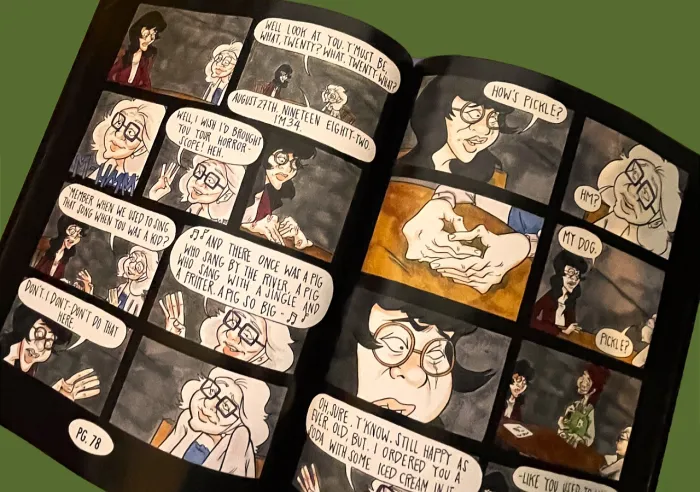JAKARTA, incaschool.sch.id – Ever noticed how a graphic novel can whisk you away, way quicker than a regular book? I remember the first time I cracked open one, just out of curiosity. That mix of visuals and storylines—honestly, it hit different. It’s not just about reading; it’s like living the story, panel by panel. Let me spill all I’ve learned (and messed up) from my crazy ride with graphic novels. If you’re a lover of comics or just curious about how graphic novels blend art and story, stick around—it’s juicier than you’d guess.
Why Graphic Novels? My Aha Moment!

I used to think graphic novels were just for kids or comic superfans. Oh boy, was I wrong! One time in high school, I borrowed “Persepolis” because someone told me it was “like a comic, but smarter.” It blew my mind—deep characters, culture, history, all told through drawings and killer dialogue. That’s when I got it: graphic novels are the real deal, especially if you’re visual like me.
Combining visual art with narrative storytelling isn’t just pretty pictures meeting text. It’s how images and words together unlock emotions, context, and action that text alone never could. From classics like “Maus” (taught me so much about WWII in a way textbooks never managed) to local gems like Faza Meonk’s “Si Juki,” the medium is unstoppable.
How I Started—and The Rookie Mistakes I Made
When I tried making my first graphic short story, I thought, “Hey, just draw some cool scenes, slap on some text, done!”… Yeah, it doesn’t work like that. My panels looked messy, and the story was hard to follow. Turns out, balancing visuals and text is an art in itself.
Here’s what I wish I knew: Keep dialogue short, let the pictures speak. Once I stopped overloading speech bubbles, my stories flowed better. Also, don’t cram too much info in one panel—give scenes space to breathe. Readers aren’t just reading; they’re soaking in the mood, colors, even little Easter eggs hidden in the background. Now, every time I draft a new story, I storyboard first. Just rough sketches, but it keeps my flow on point.
From Comic Book to Graphic Novel: Not Just Semantics
Some people still confuse comics and graphic novels. So, here’s the deal. Comics are often serialized—think “Spider-Man” or “Doraemon,” that you collect issue by issue. Graphic novels, though, are usually a full story in one book—think “Blankets” or “Habibi” by Craig Thompson. There’s more room for complex plots, rich character growth, and experimental art styles.
This format is perfect if you’re tired of linear, old-school novels. Artists like Leila Del Duca, who worked on “Shutter,” use visual cues and page layouts to guide your emotions. And hey, some Indonesian creators don’t get enough credit. Seek out Sweta Kartika’s “Grey & Jingga” if you want to see local flavor and narrative depth.
Tips to Level Up Your Graphic Novel Game
Okay, real talk—dipping your toes in graphic novels or making your own? I’ve got some tips that’ll hopefully save you the pain I went through:
- Less is more: Let pictures do the heavy lifting. Dialogues are just seasoning.
- Pacing matters: Vary panel sizes—big for drama, small for action. Your story’s rhythm depends on it.
- Choose your tools: Pen and paper are classics, but digital apps like Clip Studio Paint or Procreate are game changers (I wish I had them sooner, trust me!).
- Seek feedback: I used to hide my stories out of embarrassment, but the more you share, the sharper your work gets. Trust me, your friends (even the brutally honest ones) can spot what you miss.
- Don’t be afraid of mistakes: My best breakthroughs came from failing hard. Each cringe-worthy panel taught me more than hours of YouTube tutorials ever could.
The Data: Graphic Novels Are Booming
Ready for some numbers that might surprise you? In the US, graphic novel sales shot up 9% in 2023, hitting a record USD $1.7 billion (according to NPD BookScan). Even in Indonesia, there’s a growing scene—just walk into Kinokuniya or Gramedia, you’ll spot graphic novel shelves getting bigger every year. More schools are using graphic novels for teaching, too, because—let’s face it—students actually pay attention (I wish they used them in my day!).
Knowledge: What They Don’t Tell You in Art School
No one tells you this knowledge, but: no matter how good your art is, boring stories flop. Graphic novels succeed when both elements spark together—art and story are BFFs here. I learned that originality trumps polish. Some of my friends obsessed over perfect, glossy images, but it’s that unique storytelling voice (raw and real!) that sticks with readers. So, chase meaning, not just eye candy.
Going Beyond: What Graphic Novels Taught Me
Through mistakes and messy drafts, graphic novels taught me patience and empathy. You start seeing the world in layers—how a tilt of the eyebrows can mean more than a whole paragraph. I read “Embroideries” by Marjane Satrapi and caught nuances of Persian womanhood I’d never stumbled on before. It’s not just entertainment—sometimes it’s a crash course in culture, emotion, and nuance.
If You’re New, Try These
Don’t know where to start? I recommend trying these: “Persepolis,” “Maus,” “Habibi,” “Daytripper,” and “Si Juki”. They’ll show you how visual art and narrative storytelling combine to hit ALL the feels. And if you’re on the creative side, just doodle out your own 4-panel story—don’t wait for “perfect.”
Got Questions? Reach Out!
If you’ve got questions about graphic novels, whether it’s collecting, reading, or making your own, drop them in the comments! Seriously, no gatekeeping here. I’ve been a newbie, messed up panels, and rewritten stories a hundred times. That’s how you learn. You don’t need to be Alan Moore or a Marvel artist to start combining visual art with killer storytelling. You just have to care enough to experiment—and have a little fun. That’s what graphic novels are about.
Read also about Poetry Readings to experience the power of spoken word, connect with emotional expression, and explore how performance brings poetry to life.


